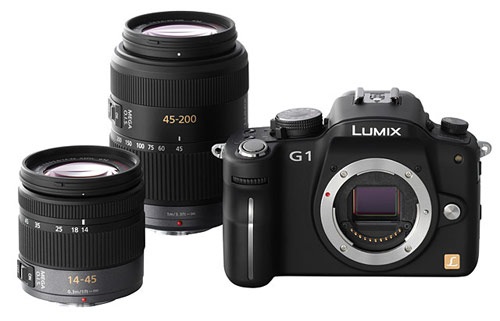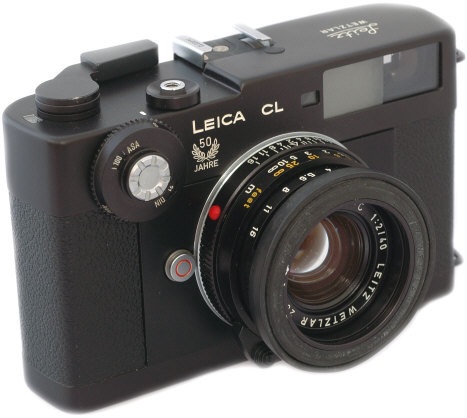Yet another format and lens mount?
When Olympus and Panasonic announced their Micro Four Thirds (what?) camera system a few months back, I confess to stifling a yawn. Yet another cropped sensor format with claims to compactness and ‘newness’. Please.
Further, reading preliminary reviews of the first camera to use this format, the Panasonic G1, left me underwhelmed. Sure, the camera was a DSLR and it was small, albeit not much smaller than the smallest DSLRs from Olympus and Pentax, and yes, the camera offered the opportunity of using rationally priced lenses from Leica not otherwise available, but as I am no lover of cropped, small sensors I gave the new products little thought.
However, I chanced on a review of the Panasonic G1 DSLR the other day and noticed something to like amongst the otherwise unexciting product features. The camera, although a DSLR, dispenses with the noisy flapping mirror and bulky pentaprism and condenser lens, replacing both with an electronic viewfinder. Heretofore, every consumer grade camera I have tried with an electronic viewfinder has been simply awful. A small, unsharp image with enormous latency (you move the camera and the image smears and follows along later) made this gimmick of no practical use for photographers. Now, maybe, things are changing, as most reviewers state that the EVF in the G1 is close to optical quality and latency is a thing of the past.
The micro four thirds system uses the same sensor size as the four-thirds one, meaning a 17mm x 13mm useable area, compared to 36mm x 24mm for full frame 35mm DSLRs. However, the cameras use a smaller lens mount for lenses, as these no longer have to be designed to clear a flapping mirror, as no mirror is used.
Why is this interesting? Well, it’s no secret that while I find the Panasonic LX-1 point-and-shoot a usable proposition – click in the left column to learn more – no one could accuse the microscopic sensor in this camera of boasting great image quality or low noise. Nor is the poor shutter lag anything to get excited about. And I continue to long for a truly pocketable camera with a proper viewfinder (no, not an LCD screen) to emulate the film Leica of yore with the addition of a half decent digital sensor. The one used in the micro four thirds cameras is many times the surface area of that in the LX1 so there is hope. As for the Leica M8, I consider its price and feature set to be nothing more than a joke. Limited automation, ridiculous and bulky variable focus length lenses (not true zooms) and a viewfinder last perfected in 1954 on the Leica M3 by a factory with little capital which checked its design originality at the door in 1938 or so.
However, the Panasonic G1 is of no interest to me, as for some reason Panasonic has seen fit to emulate the traditional SLR-looking design of the body, rather than doing something really revolutionary. Maybe they felt that buyers would turn away from something with true minituarisation and new looks, which only prompts me to ask why bother when like size can be had in the smallest Olympus DSLR for a fraction of the G1’s $800 price tag?

The Panasonic G1. Yet another DSLR-shaped waste of capital investment
But there is hope. If the EVF really is as good as the reviewers say (I have yet to try it) then there is no reason why the manufacturers shouldn’t get rid of the faux prism hump, making the whole thing yet smaller, and still permit the use of those great Leica lenses, the latter being easily the best feature of my Panasonic LX1. And, hey presto!, before you know it you have a camera as small as the Leica CL, that little jewel made by Minolta all those years ago, with all the advantages of automatic-everything and image stabilization to boot. And no noise or vibration from that wretched flapping mirror.

The (Minolta) Leica CL, first sold in 1973. A sweet full frame film camera with Leica interchangeable lenses.
So, Olympus and Panasonic, given that you have some of the best designers on this earth and have made the rational and praiseworthy decision to delegate the optical part to the best there is – Leica – why not a truly innovative update of the classic rangefinder camera body for those of us praying for something like this for over a decade? I will be the first in line to buy one if noise is low and shutterlag minimal. And while I’m at it, why is shutter lag hardly ever mentioned by reviewers? I can only think they are conflicted by commercial consderations or, more likely, judging by the quality of the test snaps included with many reviews, these people have yet to learn the difference between a good photograph and a hole in the gound.
Here is a link to get an idea of what this little camera is able to produce.
Of course I would have appreciated different pictures parameters, wide apertures, high ISO etc. …. but still it is impressive just with this “into the picture” effect it shows.
An interesting note is the forthcoming possibility of using Leica M lenses on it via an adapter. I think this will change the way many look at this camera, could it be a small M8 for 1/5th of the price ?
Michel – thanks for the link.
The problem with the Leica adapters will be that a 50mm lens will be effectively 100mm on the G1, because of the small sensor. Now that’s not necessarily bad but it raises two issues.
But the imminent availability of the adapter is, I agree, very exciting news, because you know we won’t be seeing anything like the G1’s exciting design from Leica.